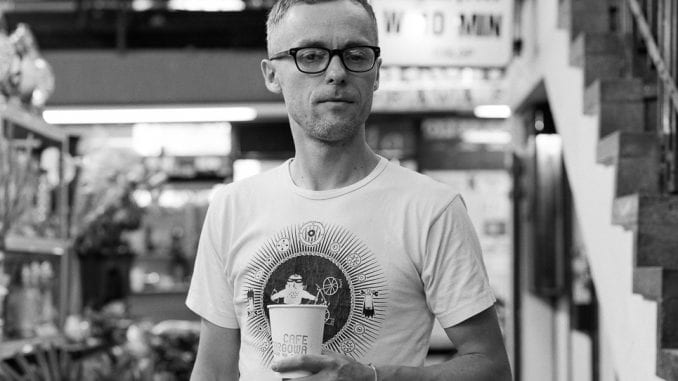
We Try Filip’s Unconventional, Winning Recipe from the 2016 World AeroPress Championship
BY JOSHUA DUSK-PEEBLES
SPECIAL TO BARISTA MAGAZINE
The World AeroPress Championship is something of a paradox. Because of its reputation as a light-hearted series of events, people are drawn to participate ”lots of people. Over the past nine months, thousands of passionate plungers, pushers, and pressers in 50 nations battled for the chance to win it all in Dublin. So much competition makes victory an intense and impressive feat, and earning the international title is a distinguished accomplishment coffee professionals keep on their CVs for a lifetime.
When the 2016 good-natured melee that is the World AeroPress Championship was finally over, Filip Kucharczyk of Poland emerged as the victor. His expression upon hearing his name called as the winner was one of pure joy, great pride, and intense relief. Interestingly, Filip’s approach to competition was utterly different than any champions who have come before him. His was a wildly different brewing recipe than judges at this high a level had seen before, as Filip essentially threw widely believed ideas about ratios and extraction out the window.

Here’s how he did it:
- Heat filtered water to around 180 °F
- Place a paper AeroPress filter in the filter basket and rinse it thoroughly
- Grind coffee coarse (Filip did 11 on a Mahlkonig EK43 and 4.5 on a Mahlkonig Kenia. I did 28 on a Baratza Encore)
- Place 35g ground coffee in the inverted AeroPress and make sure it is level
- Start a timer and spiral pour 150g water in 15 seconds
- At :15, stir with 2 chopsticks for 15 seconds
- At :30, affix the filter basket
- At 1:00, flip the AeroPress unto a cup, swirl it once, and slowly press it all the way down
- At 1:30, remove the AeroPress and add 80g water
- Stir the brewed coffee and evaluate it by tasting with a spoon
- Add up to 40g more water (according to taste), no more than 5g at a time
At first glance, the most significant feature of this method is the huge amount of coffee. At almost double a typical AeroPress dose, it’s a fascinating and noteworthy choice. Even so, after blasting through a whole bag of Metric Colombia Huila Saul Sanchez I realized that Filip’s ability to alter the strength of his coffee on the fly was what really gave him the competitive advantage.

Since the overall strength of a beverage is determined by the small percentage of it that is dissolved coffee, it’s tempting to think that diluting after brewing would alter only mouthfeel and intensity. A quick experiment using Filip’s method makes it obvious that even slight adjustments to the strength also make a big difference in how the coffee’s flavors express themselves. One of the most significant changes is in the acidity, which is a characteristic often associated much more with extraction than with strength.

But don’t just take my word for it ”here’s how you can get started playing around with Filip’s winning recipe yourself.
How To Taste Different Extraction Strengths:
- Follow the first eight steps of the recipe above and pause right after you are done pressing.
- Before you add any water, stir your brew and divide it into four equal parts by weight. They should be just over 25g each.
- Label the bottom of the first cup œconcentrate.
- Label the bottom of the second cup œ20g and add that much water to it. This will taste like the whole cup would if you added 80g of water to it.
- Label the bottom of the third cup œ25g and add that much water to it. This will taste like adding 100g of water to the whole brew.
- Label the bottom of the fourth cup œ30g and add that much water to it. This will be like adding 120g.
- Use a spoon to slurp small amounts of each, paying special attention to acidity, sweetness, and complexity.
After you have a good sense of the flavors you are experiencing, set the cup of concentrate aside, mix up the other cups, and attempt to put them back in order until you get it right a few times in a row. Try this whole experiment with several different coffees to begin your journey towards becoming a human refractometer.
Click HERE to read our interview with Filip, published on Barista Magazine’s blog on Tuesday, September 6, in which he discusses his methodology, the coffee scene in Wroclaw, Poland, and much more.
ABOUT THE AUTHOR
Joshua Dusk-Peebles is a lifelong explorer, experimenter, and learner. He enjoys nothing more than sharing what he is learning with other people. When he was young, he would get legitimately angry if his dad forgot to let him smell the coffee every time a new bag was opened. Unfortunately, the much less pleasant corresponding beverage kept him away from coffee until his 30s, when he smelled and then tasted a well-handled natural process Ethiopia Yirgacheffe, and everything made sense again. He plans on getting his own new-born son started much sooner. He can be reached at dusk.peebles@yahoo.com


